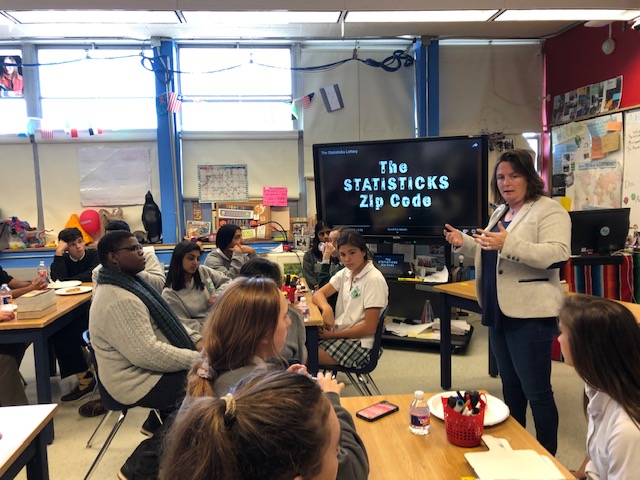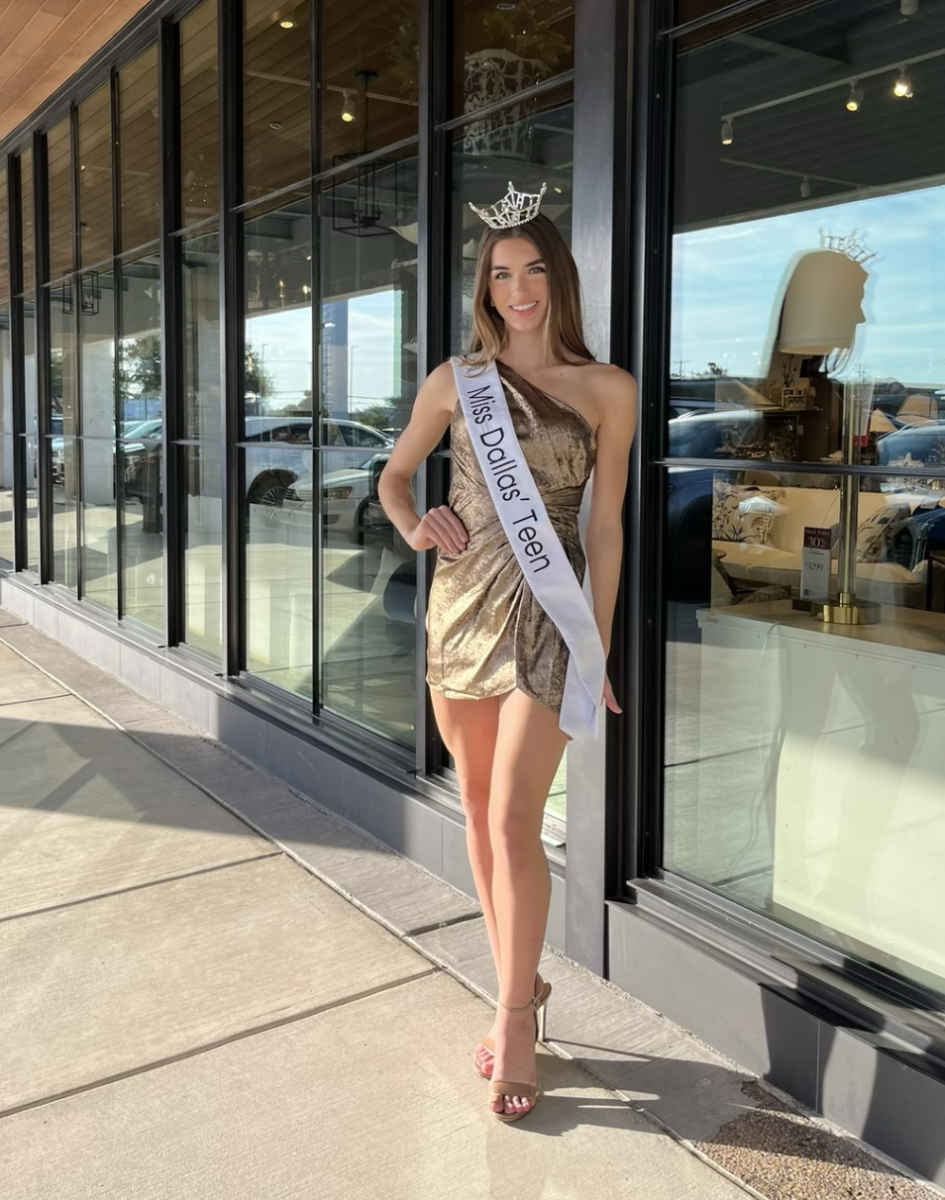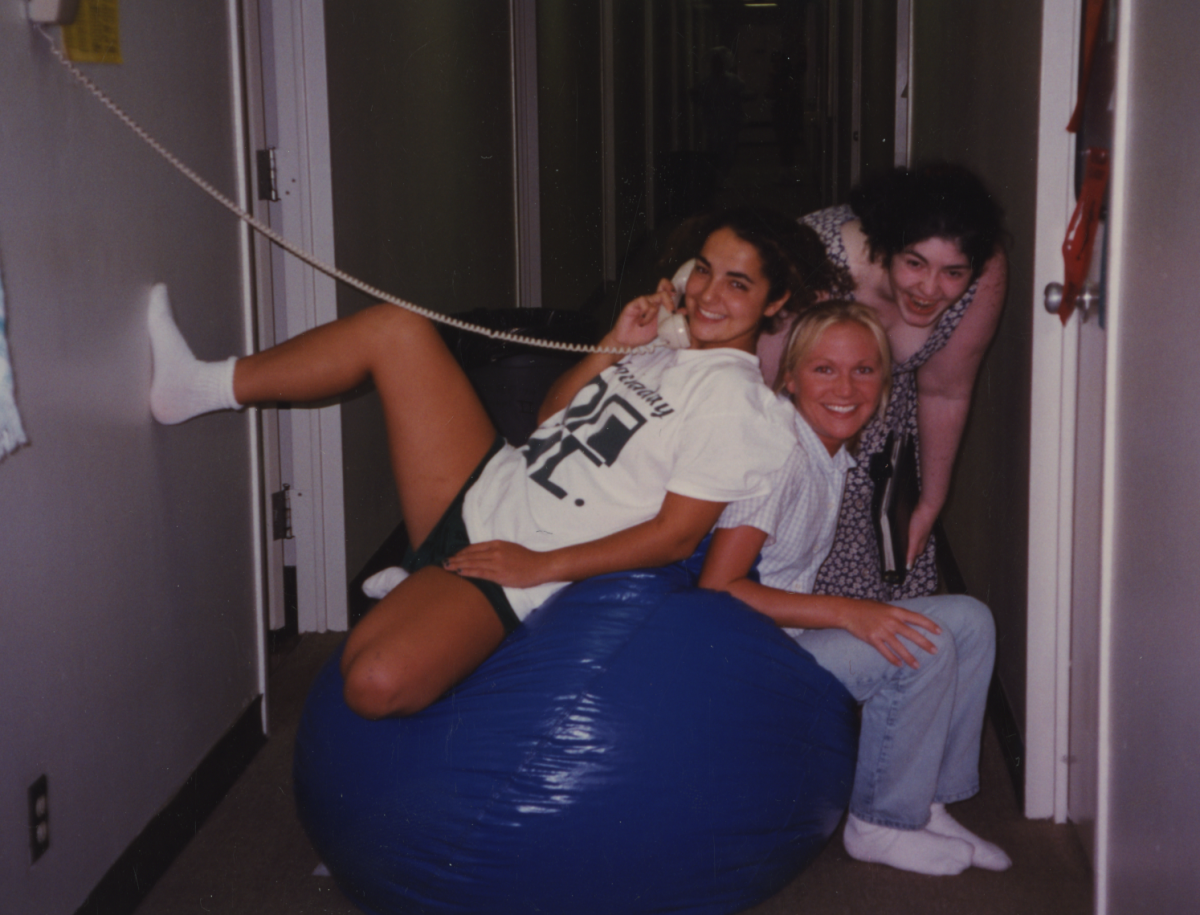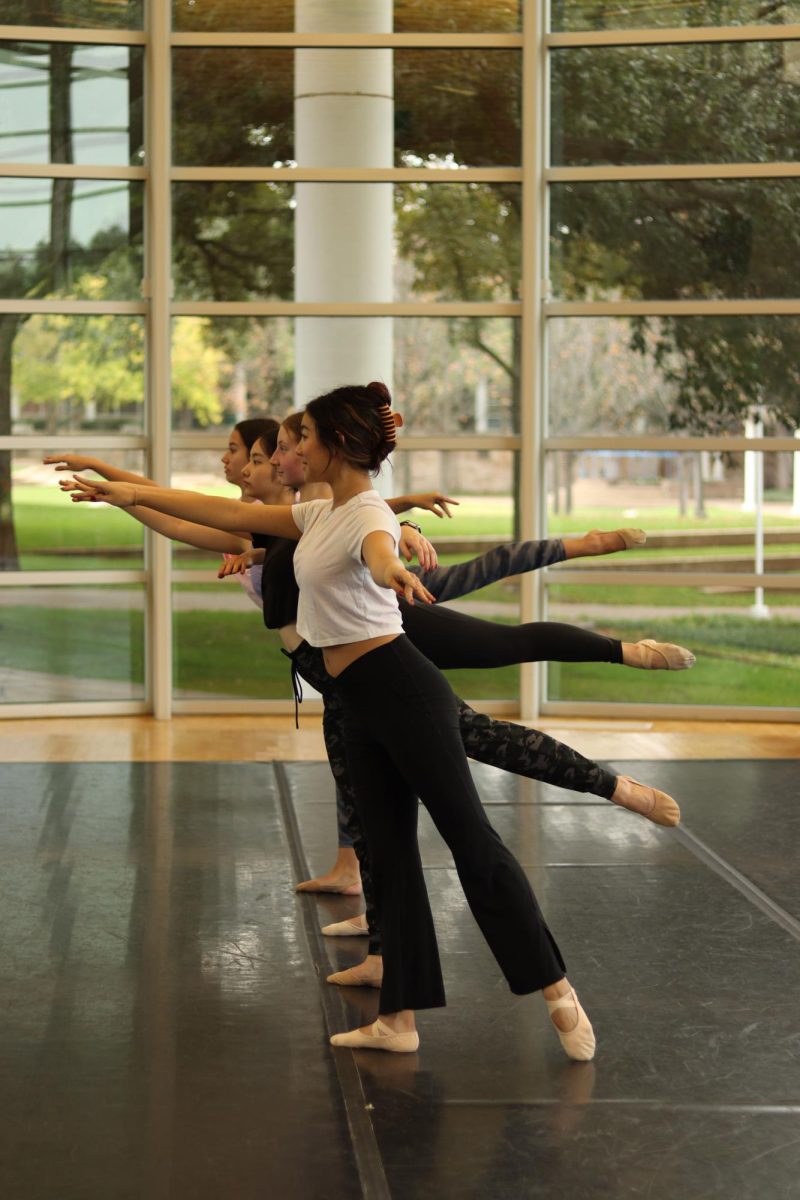The Fourcast spent a day at three schools to learn about their academic and social cultures.
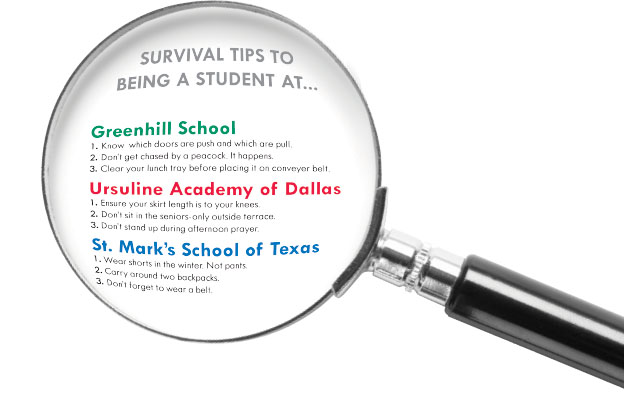
Greenhill School
4141 Spring Valley Road, Addison, TX 75001
When you hear the wails of a peacock in Dallas, you know you’re at Greenhill School. Perhaps the only high school in the country with peacocks free to roam around on campus, interact with students and every so often sneak into buildings. But how different can it really be from Hockaday? It goes far beyond just the lack of uniform and the presence of, well, boys.
Greenhill is known as a very close, tight-knit community. And after being there for an entire day, that was evident. Everyone knew everyone else regardless of the grade difference. An entire grade’s lockers are crammed into a room half the size of one of Hockaday’s classrooms, so students quickly become familiar with each other.
Walking through school first thing in the morning, students aren’t strewn across the hallways half asleep. Instead, they’re huddled over tables in their respective pods, relaxing or finishing last-minute work. The Upper School is dispersed into four pods, each one containing all classrooms of a single department, with the exception of science which has its own building. Classrooms have clear, glass walls and none belong to a specific teacher. Teachers, instead, have their own cubicles in the center of each pod and move into a classroom to teach.
Although passing periods are only five minutes, Greenhill has no bells to affirm a student’s
tardiness.
Each morning they sign in with a teacher at the Elliott Center, a student common area, before heading to first period.
And it turns out, Hockaday isn’t the only school which always ends up discussing gender issues and roles. Juniors in the English trimester class, Nature and Uses of Language, engaged in dialogue about the meaning of masculinity and femininity and how society traps individuals into boxes which stringently define gender roles. The conversation quickly transitioned into the prevalence of media in society and its influence on lifestyle and life choices. Almost all students were attentive, engaged and actively participating, discussion occurring without hand-raising.
“I’ve always run my classes where I’m not the one talking, ”English Department Head Linda Woolley said. “I value [the students’] opinions and shape their critical thinking habits.”
Students also find the learning environment at Greenhill to be unique and exclusive to the Greenhill community. “[Classes] can seem a little bit chaotic and unstructured, but when you take a step back at the end of the day, you think that this is something that would’ve only come from Greenhill,” junior Alex Weinberg said.
Students say they like the co-ed environment because it allows for a wider range of perspectives and they can’t imagine it any other way.
“The attitudes of girls and guys are really different and being around them allows me to see the other side of things,” junior Supriya Bhargava said. “A lot of my friends are guys and being around them everyday really makes a difference.”
Both the boys and girls say that they enjoy not having a uniform, not only because it allows them to express themselves freely, but also because it’s just easier and more relaxed to wear whatever they want. “As a school, we celebrate diversity,” said junior Rachel Diebner. “And part of that diversity is the freedom to express yourself as an individual through your clothing.”
Students are not secretive about their grades. Quizzes lay face up on desks during AP Spanish, and the teacher even placed a golden paper crown on the student with the highest grade. But in no way did that instill a ferocious sense of competition.
At Greenhill, advisory serves as a break from class and a time to hear announcements from advisors, rather than a time gorge down a late breakfast. Moreover, Greenhill students do not have lunch included in their tuition and many students bring their own lunch and eat in classrooms or pods.
Greenhill prides itself in its diverse student body that makes the educational experience more varied.
“I don’t think I’ve ever been at a place that welcomes and helps students develop so many individual talents,” Woolley said.
-Anisha
Ursuline Academy of Dallas
4900 Walnut Hill Lane, Dallas, TX 75229
The iconic image of the Ursuline Academy of Dallas is the first any new arrival to the campus sees: the white statue of the Sacred Heart of Jesus, colloquially known as “The Jesus Statue.” It’s also the location of the last rite of passage for each of Ursuline’s students, as each girl performs a deep bow during her commencement ceremony.
The all girl Catholic school incorporates faith in many ways. Required prayer before and after school, faith classes all four years, occasional all school masses and its leadership by the Ursuline sisters all are part of “spiritual formation and faith development,” part of the Ursuline mission.
“We don’t really have Cornerstones [like Hockaday],” said Ursuline junior Shannon McFall, “but the one word that I would put as sort of a Cornerstone for Ursuline would be Serviam. It means ‘I Will Serve’ in Latin.”
Through its Global Education, the school incorporates service into all its classes and runs exchange programs and mission trips to various areas throughout the summer and academic year.
“For my computer class I had to make an app helping refugees,” junior Mariama Tejan said. “In my math class I made a graph of the various prices of fruit and vegetables in developing countries. Even in art class they make portraits for kids in third-world countries who couldn’t afford [art].”
Ursuline girls walk through campus in red, white and blue skirts that reach barely above the knee as well as Oxford shirts, white socks and saddle shoes. Sweaters and fleeces (no sweatshirts) keep students warm except on infrequent dress uniform days, when dark blue blazers form a sea of navy during all-school Mass.
Ursuline runs on a 80-minute class block schedule. The time of each class rotates, so that a schedule in the order 1234 will on another day read 4123. However, students don’t have a free period as a result of the added academic period for faith classes.
Lunch at Ursuline offers numerous options. Many students bring their own lunch, panini presses lie at various points around the room, a student-run Breakfast Club sometimes makes pancakes on portable griddles instead of eating the normal lunch fare and girls pay for food, item by item, after standing in several different lines.
Ursuline girls don’t generally have the option to snack during advisory because they only meet for 45 minutes once a week.
“Food depends on the advisory,” Tejan said. “Some don’t bother, some assign someone to bring food every week.”
Ursuline may be older than Hockaday (it was founded in 1874), but Ursuline has kept up with the times in many ways.
Though Ursuline doesn’t use SmartBoards, it isn’t low-tech. The LEED-certified French Family Science, Math and Technology Center, which opened in 2009, suggests otherwise, especially when coupled with Ursuline’s laptop program which includes Toshiba and tiny Fujitsu computers.
Ursuline restricts very few websites, allowing free access to Facebook. The school uses programs like MyBackPack, Dyknow Interactive Learning Software and Blackboard to communicate grades and school information to its students.
In the classroom, Ursuline girls respond to teacher questions out loud, whether their responses are right or wrong. They sometimes have side conversations with their peers. They are never distracted by boys.
“Each class is closely knit, which makes all of the students challenge themselves in our daily group discussions,” junior Amanda Boe said. “The class environment is very fun at the same time because we have a close relationship with our teachers and they have us do fun group activities and competitions during class.”
Boe also praised the small class sizes, which she said all students “stand out in their own way in class.” Tejan, a tour guide for the school, said that most classes have around 18 students.
Religion runs throughout the backgound of the Ursuline experience, from the crucifixes in nearly every room to the giant stained glass window just outside the cafeteria.
“I have a bible in my backpack,” Tejan said.
-Emily
St. Mark’s School of Texas
10600 Preston Road, Dallas, TX 75230
With Hockaday’s centennial in the horizon, it’s common knowledge within our community that Ela Hockaday established our school almost 100 years ago. What might not be so obvious, however, is that only a few years before she did, St. Mark’s School of Texas founder M. B. Terrill suggested the idea of creating an all-girls school to her and urged her to act on it.
Take a walk around the St. Mark’s campus, and upon first glance, you’ll notice the various backpacks that line the hallways, classrooms and lunchroom.
“When you see people walking to school, they have two backpacks: one for the morning and one for the afternoon,” sophomore Conner Olson explained. “They bring their afternoon backpack in the morning and leave it at school and then switch them out in the afternoon.”
Apart from the backpack culture, there’s surprisingly a lot that Hockadaisies probably don’t know when it comes to their brother school.
And although St. Mark’s and Hockaday students may end up learning the same academic material, the methods by which they do so significantly differ. At St. Mark’s, students have eight 45-minute periods and meet with each class daily. Many, however, have a couple free periods interspersed throughout the day.
Uniforms comprise of white Oxford shirts and gray shorts from Culwell & Son for students in first through eleventh grades. Seniors don blue shirts, and college sweatshirts are popular among students in all grade levels.
Classrooms are grouped by department in multiple buildings, with the exception of the science department, which has its own building. In one senior AP English class, boys passed around a carton of animal crackers while participating in a discussion about societal expectations based off of Kazuo Ishiguro’s “Never Let Me Go.” Not one student opened his book during the entire class for textual evidence. They used the novel as a basis, but most cited their own life experiences to supplement their comments.
In humanities classes, teachers sat alongside students around a large, oval wooden table—classrooms exuded a relaxed and comfortable atmosphere.
“It’s a lot different here than from Hockaday,” senior Daniel Hersh said. “People are more open about their grades, and there’re a lot of friendly rivalries.”
Students, however, are anything but careless with their studies.
“I know that the boys are capable of the work I present, which is a luxury for a teacher to have,” Upper School history teacher Dr. Bruce Westrate said. He noted that he hasn’t had to simplify the classroom strategy he used while teaching at Indiana University.
“They take advantage of the fact that there are a lot of teachers around that are delighted to meet with them,” Upper School math teacher J.T. Sutcliffe said.
As for the school’s social dynamics, students attested to an overall friendly vibe. “It’s such a diverse community that you can basically have any opinion and you’ll be fine,” Czech foreign exchange student and junior Lukas Jendele said. And despite this diversity, most students confidently stated that they knew and were on good terms with everyone in their grade.
While some may believe the all-boy environment deters students, most agreed that it actually benefits their experiences at school.
“There’s so many things that we would not do if girls were around,” junior Harrison Lin said. “You see people in the lounges being total slobs all the time.”
Being in a classroom with only boys provides students with more than the chance to let loose. For junior Yima Asom, a single-sex surrounding instills confidence.
If girls were around, he said that he “would feel as if they were constantly judging me. I wouldn’t be as focused.”
St. Mark’s mission statement is to attempt to prepare boys by encouraging leadership opportunities, endowing students with responsibilities and emphasizing hard work for long-term gratification.
“We put the mission in front of us whenever we’re making major decisions,” Eugene McDermott headmaster Arnold E. Holtberg said. “It’s essential that we remind ourselves what our core values are.”
For most students, embodying the school philosophy is a tough feat but one that is widely appreciated.
“You learn a lot. You do a lot. You achieve a lot,” sophomore Nick Buckenham said. “Ten years from now, I’ll definitely look back on St. Mark’s as one of the most, if not the most, defining aspects of my life.”
-Amy


